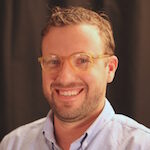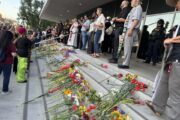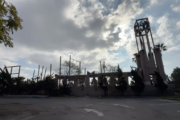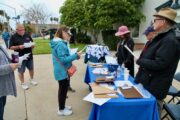“When people ask me, ‘What good can come out of Skid Row?’ I tell them that the people of God come out of Skid Row!” Pastor Cue’s sermon hit a crescendo as he preached on the corner of Wall Street and Winston Street in the heart of downtown Los Angeles. The rats scampering in and out of trash piles a few yards from the portable pulpit went unnoticed, and shouts of “Amen!” rose from the 60 worshippers sitting in folding chairs on the sidewalk, standing on the curb and spilling over into the street. Pastor Cue closed his homily by telling the congregation that their hope in Jesus was more significant than their pain. Then he prayed for the bread and grape juice before they were distributed for communion.
The Row, or the “Church Without Walls,” is an independent congregation that has met on the same Skid Row corner for eight years. Though they serve meals after the service, it is a church. Some congregants live on the street, others in the SRO apartments scattered throughout downtown and others commute from Orange County to attend the weekly Friday night services. After the communion elements found their homes, the pastor asked if anyone needed prayer, and a handful of individuals came forward. As they relayed their prayer requests, the “Power Sisters,” a small group of women in their 50s and 60s, got up from their chairs and placed their hands on the shoulders, arms and heads of the petitioners and began to pray for them in tongues.
The Pentecostal turn of the Row’s worship service has historical significance: The corner of Wall and Winston is less than half a mile from 312 Azusa Street, the contested birthplace of the contemporary global Pentecostal movement. A hundred years ago William Seymour led a spiritual revival that was fueled by the same type of glossolalia prayed by the Power Sisters, and the Row shares more than just the style of prayer with America’s first modern Pentecostal group. Like Seymour’s church, the Row is led by an African American pastor who did not graduate from seminary, has a richly multi-ethnic congregation and is the spiritual home to many people living on the stigmatized margins of Los Angeles. William Seymour might feel right at home.
But the Row is not the only manifestation of Pentecostalism operating in close proximity to 312 Azusa. Earlier this year, Hillsong, a Pentecostal church based in Australia that has made its mark on global Christianity through its music, started meeting at the Belasco Theater in downtown Los Angeles. In size and style, Hillsong’s worship services look more like an arena rock concert than the Row’s meetings. And Hillsong’s target audience is more likely to live in DTLA’s glass and steel lofts than in the Coleman tents propped up on Skid Row’s sidewalks or the SROs on San Pedro Street. Despite the differences in production style and the target demographic of each church, both the Row and Hillsong can trace their roots to the Azusa Street revival.
Pentecostalism in downtown Los Angeles extends well beyond the Row and Hillsong, but this pair of groups illustrates two of the themes that emerged in CRCC’s Pentecostal and Charismatic Research Initiative. First, as the number of practicing Pentecostals has grown from a few hundred to hundreds of millions over the last century, the faith has maintained its unique resonance with society’s poor, oppressed and stigmatized. But in the last few decades, Pentecostalism has also made significant inroads into the rising middle-class throughout the world. Though Seymour’s congregation has long since vanished, DTLA is still an important place in global Pentecostalism because the neighborhood’s ongoing spiritual innovations speak to the past, present and future of the faith.
Andrew Johnson is a contributing fellow with the USC Center for Religion and Civic Culture.








